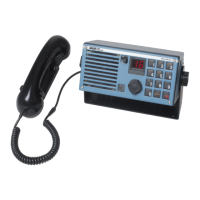5 CIRCUIT DESCRIPTION AND SCHEMATIC DIAGRAMS RT2048
Page 5-12
0820
5.4. RX/TX UNIT (MODULE 4)
The RX/TX unit comprises the following circuits:
The receiver including detector
AF power amplifier
RF power amplifier
Harmonic filter
RF power control
8V power supply
5.4.1. RECEIVER FRONT-END
The RF amplifier covers the frequency range 154.400 MHz to 163.600 MHz and consists of the low noise Dual Gate
Si-Mos-FET Q11 surrounded by two high Q double-tuned bandpass filters.
From the aerial the signal is led through the aerial relay to the receiver input bandpass filter. The input bandpass
filter as well as the intermediate bandpass filter are controlled by a DC voltage on the tuning diodes. This DC voltage
derives from the RX VCO control voltage and secures an optimum filter response in the whole frequency range of
the receiver.
The two bandpass filters create the necessary attenuation of unwanted signals.
5.4.2. FIRST MIXER
The balanced mixer has good large signal properties, securing good intermodulation characteristic.
The mixer transistors Q08 and Q09 are of the J-FET type.
The signal is led to the balanced input transformer TR2 and then to the gates of the J-FETS, which are switched
by injecting the first LO signal into the sources. The mixed signals are fed to the balanced output transformer TR1
where the wanted signal on 15.3 MHz is selected by the tune circuit consisting of TR1 and C75.
R06 and R01 create the necessary impedance matching the IF crystal filter.
5.4.3. CRYSTAL FILTER
The receiver adjacent channel selectivity is maintained by means of the crystal filter FL2 in co-operation with the
ceramic filter FL1. R57 and R39 give the impedance matching the crystal filter output.
5.4.4. IF AMPLIFIER
The transistor Q10 amplifies the signal to the 2nd mixer, which has a tuned drain circuit consisting of L04 and C32.
R34 creates the impedance matching the 2nd mixer.
5.4.5. SECOND MIXER, CERAMIC FILTER, DETECTOR AND AF AMPLIFIER
The second LO signal 14.850 MHz is amplified in Q02 before it is delivered to the mixer.
The signal out of the mixer (450 kHz) is fed through the ceramic filter to the limiter amplifier and discriminator in
U03.
The phase shift network to the quadrangular discriminator consisting of R11, L06, C33, and a 10 pF capacitor inside
the IC.
AF output is led through a lowpass filter consisting of R36 and C74, which removes the high frequencies (450 kHz).
An internal operational amplifier amplifies the AF signal to 250 mV, which is adjusted by R20.
5.4.6. AF POWER AMPLIFIER
The AF power amplifier is capable of delivering 6 Watt in the internal loudspeaker (4 ohm) and 6 Watt in an external
loudspeaker 4 ohm.
The gain of 34 dB is fixed by the resistors R07, R08 and R09.
The AF power amplifier is muted (pin 11, 0 = off, 1 = on) about 1.25 sec. after the squelch is closed.
5.4.7. RF POWER AMPLIFIER
The power amplifier covering the frequency range 154.4 MHz to 163.6 MHz consists of a module with 50 ohm
terminations and 2 amplifiers. The first amplifier is the driver which has a gain of up to 12 dB, depending on the
driver voltage from Q01. The input is about 200 mW.
The second amplifier has a gain of 10 dB.
5.4.8. HARMONIC FILTER
The harmonic filter is realized as a seventh order Chebyscher filter, which at the same time will provide the
necessary attenuation of the harmonic generated by the power amplifier and a low insertion loss at the carrier
frequency.
The output is fed to the antenna relay.

